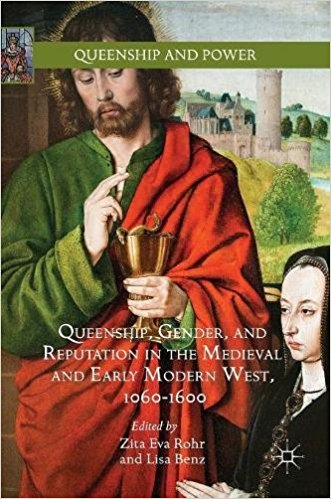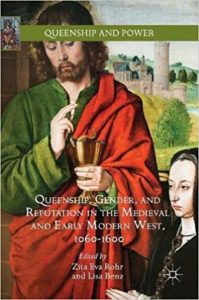
Queenship, Gender, and Reputation in the Medieval and Early Modern West, 1060-1600 by Zita Eva Rohr and Lisa Benz
This is part of our special feature The Gender of Power.

Queens in medieval and early modern Europe represented a tiny minority of women, but they were a varied lot: some queens by marriage, some by inheritance, each subject to traditions and legal customs that varied widely. Their experiences obviously changed over time and space, as well – the sources of power and range of motion of a Saint Balthild (d. 680), an Anglo-Saxon raised from slavery to be the Frankish king’s bedfellow, for example were significantly different from that of an Isabel la Católica (d. 1504), who claimed the throne of Castile through inheritance and ruled over an emerging empire. They shared in common, however, the dominion of Christendom, and Christian ideas about the behavior and function of women, which were imposed upon them. This milieu, more than anything else, raised the significance of the queen’s reputation to the fore. Queens who did not conform, or more significantly were not perceived to conform could place themselves, their husbands, or children, or their very realms in a precarious position indeed. And it was a slippery slope: from a reputation as a good Christian emerged reputations for good motherhood, for sexual purity, for wise counsel, for charity, for modesty, and so on. Accusations of being bad mothers, sexual deviants, schemers, or profligates challenged Christian ideals and possibly more importantly, political stability.
Queenship, Gender, and Reputation takes up the crucial theme of reputation in the study of royal women, in eight essays which range from the medieval to the early modern, and from Scandinavia to Central Europe to Iberia in scope, although in fact, seven out of the eight essays focus on the late medieval and early modern period, and the majority focus on French or English queens and historiography. The contributors come from the fields of history, art history, and literary studies; the essays themselves are interdisciplinary. The introduction is a tour de force of the state of the field of queenship studies. Lisa Benz and Zita Eva Rohr locate at the core of modern scholarship the work of John Carmi Parsons, especially the seminal publication of Medieval Queenship in 1994, which first collected modern scholarship examining the office and institution of queenship. Parsons moved beyond biography himself in his monograph Eleanor of Castile: Queen and society in thirteenth-century England (1998) in which he modeled a study of how Eleanor’s queenship functioned, looking at her motherhood, her household, her landholding – and, indeed, her reputation. Scholars of medieval women from any discipline must consistently reckon with the “agendas,” “prejudices,” “expectations and perceptions” of their sources, features which shaped reputation. As the editors point out, “reputation is a strong undercurrent in almost all studies of medieval queenship.” (“Introduction,” xxx) This collection is a welcome addition to considerations of how reputation was shaped and confronted.
In the first section, titled “Biography, Gossip, and History,” four essays especially pay attention to methodology and historiography, as they seek to demonstrate how historical reputation (or even knowledge) about women was formed – though material objects, propaganda, and historical writing. In “Lifestyles of the Rich and (In?)Animate: Object Biography and the Reliquary Cross of Queen Adelaide of Hungary,” Christopher Mielke elucidates the significance of the “Adelaide Cross,” an eleventh-century crux gemmata, or bejeweled cross, originally commissioned by Adelaide of Rheinfelden, queen of Hungary (d. 1090) as a memorial to her mother, Adelaide of Savoy (d. 1079). Adelaide gave the cross, a reliquary of the True Cross, to the abbey of St. Blaise, where she wanted to establish a sort of family pantheon. The cross has been reworked repeatedly over the centuries, first by the monks of St. Blaise in the twelfth century. Even as they altered the cross, however, they recorded its history – and thus the history of Adelaide. Mielke argues that through the method of object biography, we can discern how Adelaide sought to shape her own reputation (emulating the first queen of Hungary, Gisela) and how her reputation was subsequently shaped by those interacting with the cross itself. This methodologically rich essay offers a way to understand the sort of power wielded by a “mostly unknown queen.”
Tracy Adams, in “Gender, Reputation, and Female Rule in the World of Brantôme” teases out a new reading of the Vies des dames ilustres and Vies des dames galantes (known together as the Recueil des dames) by the sixteenth century lord of Brantôme, Pierre de Bourdeille. These texts have long served as authentic and credible sources for the French courts, even as Brantôme is known to have constructed, if not outright plagiarized many of his “observations.” This flexible approach by both Brantôme and subsequent historians has had significant impact on the historiography (and thus reputation) surrounding the French queens Anne of Brittany and Anne of France, their putative rivalry, and Anne of France’s reputation as a domineering wife. Adams does not “seek to deny Brantôme’s historical value… but to suggest ways of putting some of his anecdotes to good use.” (30) She persuasively argues that gender stereotypes which animate the historiography (early modern as well as modern) might be read in a multiplicity of ways.
Zita Eva Rohr’s essay, “True Lies and Strange Mirrors: The Uses and Abuses of Rumor, Propaganda, and Innuendo during the Closing Stages of the Hundred Years War,” makes two important points. First, in the fraught circumstances of the French court circa 1400, understanding how rumor and innuendo worked against women, often through the mechanism of propaganda, historians must look to the men. Second, rumor often was perceived to be “more true” than other sources of information. By tailoring and placing rumors carefully (Rohr’s “bespoke rumor”), the Dukes of Orleans and Burgundy adeptly manipulated popular opinion, and created intolerable conditions for the sisters-in-law Valentina Visconti and Isabeau of Bavaria. For example, accusations of debauchery and profligacy were epitomized in a sermon preached by Jacques LeGrand, and echoed by others, including Christine de Pizan: this became truth. The reader is taken on a forced march, through a complicated, academically contested period; Rohr writes in an entertaining but colloquial style, so patience will be demanded of some readers.
In “Etienne Pasquier on French History and Female Strategies of Power” James H. Dahlinger straightforwardly argues that the late sixteenth-century French jurist Etienne Pasquier “thought that women inevitably played a central role in building the political and cultural life” of France. (77) Pasquier’s Recherches de la France and his correspondence demonstrate a thinker who took women’s place in history seriously, if not always with full or correct comprehension of that history. Dahlinger suggests that Pasquier’s positive view was influenced by his own experience of companionate marriage, as an “advocate of gender parity avant la lettre,” and more significantly, intuiting the power and influence women had in the political arena when they had the king’s ear. (80) In his Recherches, Pasquier pointed to historical models like Blanche of Castile, and more extensively the Frankish queens Fredegund and Brunhild to make a case for women’s role in government. “Pasquier asserts through his text that queens regent or queens consort provided maternal nurturing for the psychic and social fabric of the State and were necessary, female embodiments of reassuring continuity in the midst of chaos.” (92); Dahlinger’s shows how these earlier queens set a precedent, according to Pasquier, for “serviceable models of the praise and blame that accrue to royal conduct” (92) in a time when the current queen, Marie de Medici, was severely challenged.
The second section, “Politics, Ambition, and Scandal,” also attends to historiography, but focuses more on individual queens. In an outstanding essay “The Unruly Queen: Blanche of Namur and Dysfunctional Rulership in Medieval Sweden,” Henric Bagerius and Christina Elkholst, introduce us to the unlikely network of Blanche of Namur, her husband King Magnus Eriksson and their favorite (and possible lover) Bengt Algotsson – and the critical writings and circle of St. Birgitta of Sweden. The royal marriage under any circumstances reflected a union meant to stabilize the realm and epitomize good government. Blanche’s reputation as a filicide, married to a weak king who did not control her, served to justify Magnus’s eventual deposition. Birgitta’s Revelations, and a pamphlet titled Libellus de Magno Rege, pointed to an inversion of appropriate gender relations within the royal couple, and thus threatened the health of the realm.
In “Conspiracy and Alienation: Queen Margaret of France and Piers Gaveston, the King’s Favorite” Lisa Benz reviews the conspiracy to remove Piers Gaveston’s influence over King Edward II of England in light of the career of the dowager Queen Margaret, Edward’s stepmother. As queen, Margaret had routinely interceded with the king, even on behalf of her stepson, with whom she had a good relationship. However, as dowager, Margaret faded from the scene. Benz suggests Margaret joined a noble conspiracy against Gaveston because Edward had reallocated the queen’s lands, so essential to her ability not only to live well but to gather a retinue and to act politically. In the long run, she won her dower back, but lost her influence at court. Margaret had overstepped acceptable bounds of “appearing to be submissive when she was in power …[and using] influence in a manner that recognized the king’s authority.” (132)
Like Benz, Rachel C. Gibbons returns to well-known sources with a fresh take. “Isabeau of Bavaria, Queen of France: queenship and Political Authority as “Lieutenant-Général” of the Realm” takes another look at the context in which two ordinances establishing regency were produced in the reign of Charles VI, and the significance of these ordinances for the power and range of authority of Queen Isabeau, Charles’s wife. In 1402, when the king was first seized with what became an enduring mental illness, Isabeau was established as regent. However, in 1403, it became clear that a less temporary arrangement needed to be made, and thus a regency council was established, with Isabeau as its chair. Gibbons argues that this was not a slight to Isabeau, reflecting a reputation as a flighty incompetent, but rather was a solution to bring about a more stable political régime.
“Leonor of Navarre: The Price of Ambition” by Elena Woodacre takes up the history of the fifteenth century queen of Navarre and her “black legend:” the second daughter of Juan of Aragon, regent of Navarre, Leonor appears to have colluded with her father to prevent her elder siblings (Carlos, the Principe de Viana, and Blanca) from inheriting the throne. Woodacre argues that what has been condemned as overweening ambition might be seen as “keen survival instinct” if we peel away the centuries of early modern and nineteenth century historiography casting Leonor as a plotter and poisoner, willing to sacrifice her own sister and even her children in order to seize power. Woodacre’s foray into nineteenth-century travel writing which promoted and shaped the legend of Leonor as a ruthless kinslayer is fascinating.
Reviewing collected editions is notoriously difficult, and space limitations preclude more than brief summaries of each essay. As a whole, the collection is useful and interesting, but not without flaws. A number of the essays suffer from poor editing, which is frustrating. Mielke’s essay on Queen Adelaide and her cross does not fit with the other studies, and here the editors missed an opportunity, perhaps to push the other contributors to think about legend and rumor as objects subject to biography, or better, to introduce other scholarship into the collection, to make it a true survey of the problem of reputation and premodern queenship. The other seven essays speak to each other in interesting ways. A general, concluding essay on how these works demonstrate the crucial approach of returning to primary sources and bringing a critical eye to early modern and modern historiography – arguing that this is essential for modern studies of queens, queenship, and women in power generally, could have served to tie the individual essays together.
Reviewed by Miriam Shadis, Ohio University
Queenship, Gender, and Reputation in the Medieval and Early Modern West, 1060-1600
by Zita Eva Rohr, Lisa Benz
Publisher: Palgrave Macmillan
Paperback / 214 pages / 2016
ISBN: 978-3-319-31283-5
To read more book reviews, please click here.
Published on July 6, 2017.




